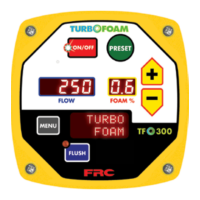TFC100 Rev180215
54
Install Flow Sensor(s)
There are several ways to install paddlewheel type ow sensors. Mounting options include saddle clamps,
weldments, pipe tees, and special adapters. Each mount meets a particular plumbing requirement.
Flow sensors are interchangeable. It is recommended to check display accuracy if sensors are swapped and
calibrated when necessary.
The maximum ow sensor pressure is 700 PSI (48 bar).
Flow Sensor Location
Locating the ow sensor in the plumbing system is critical. The ow of water at and around the sensor must
be laminar, or smooth, to ensure accurate ow rate measurement. There must be enough straight pipe before the
ow sensor for the water stream to stabilize into a uniform ow. Guidelines for selecting ow sensor locations
are outlined in the following gures.
Turbulent Water
When the ow sensor is mounted after an area in the plumbing that tends to increase water stream turbulence
(a valve, increase in pipe diameter, etc.), it is critical that steps are taken to stabilize the ow. When a pipe is
reduced in diameter, the water stream tends to be squeezed into a more uniform ow. This can help stabilize ow
when there is not sufcient straight pipe up stream.
Figure L11. Flow Sensor Location Guidelines
The preferred location for mounting a ow
sensor is on the top half of the pipe. The
best orientation is vertical.
When mounting a sensor after the pipe
diameter is reduced, length L must be at
least 2 times the pipe diameter.
When mounting a sensor after a valve,
length L must be at least 14 times the pipe
diameter.
When mounting a sensor after an elbow,
length L must be at least 6 times the
pipe diameter.
When mounting a sensor before a valve or
an elbow, length L must be at least equal
to the pipe diameter.
Before Valve or Elbow
L > 1 X PIPE DIA.
After Elbow
L > 6 X PIPE DIA.
After Valve
L > 14 X PIPE DIA.
After Reduction
L > 2 X PIPE DIA.
Best Flow Sensor
Orientation is Vertical
L
L
L
L

